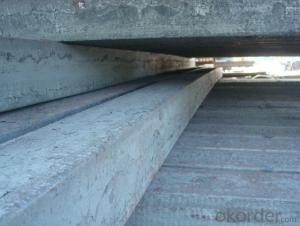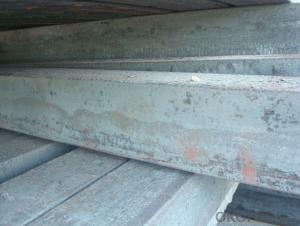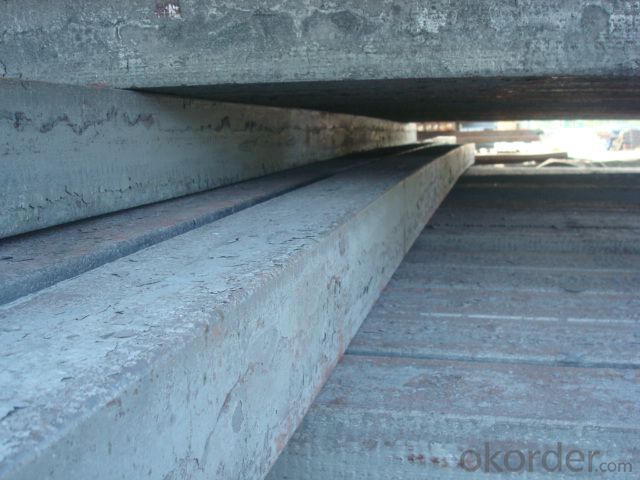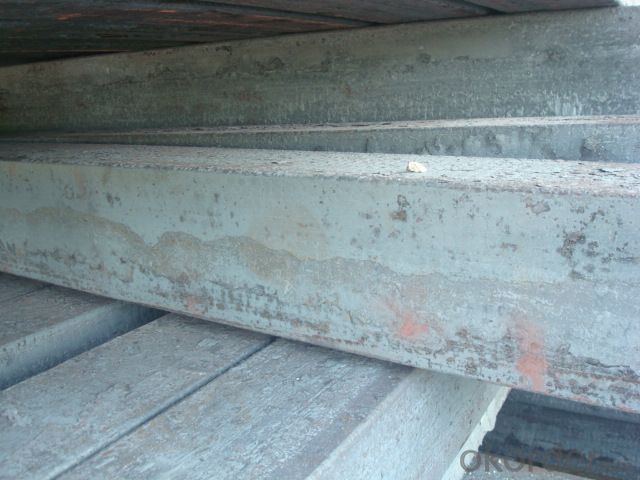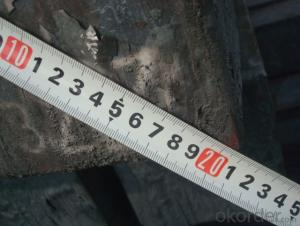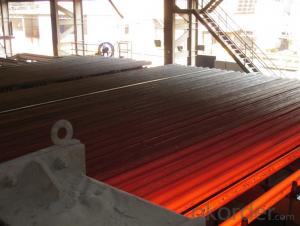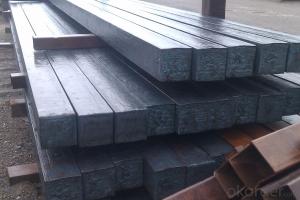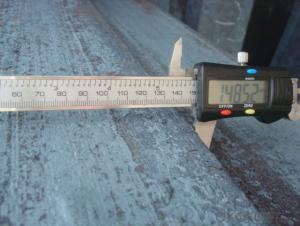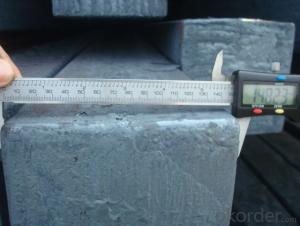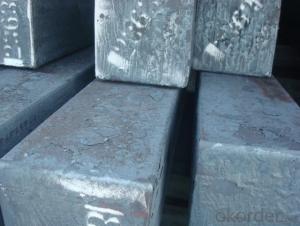Steel Billet Produced by Big Blast Furnace
- Loading Port:
- Tianjin
- Payment Terms:
- TT OR LC
- Min Order Qty:
- 1000 m.t.
- Supply Capability:
- 100000 m.t./month
OKorder Service Pledge
OKorder Financial Service
You Might Also Like
Steel Billet Produced by Big Blast Furnace
1.Structure of Steel Billet Produced by Big Blast Furnace
Steel Billet Produced by Big Blast Furnace Billet section of square, round, flat, rectangular and abnormity, etc Several, mainly related to shape of rolled products. Simple rolled section steel, choose cross section of square billet or rectangular billet. rolling The sector products such as flat steel, Angle steel, select the rectangular billet or slab. Had better profiled billet when production beams, channels, and in rolling process Lines and improve the yield. The raw material of round billet is the production of seamless tube.
2.Main Features of Steel Billet Produced by Big Blast Furnace
Steel Billet Manufactured by Blast Furnace without Boron section size should meet the requirements of rolling deformation and finished product quality, but also roll strength and biting condition of restrictions. General steel Billet section height H. And the roll diameter D The ratio of the ( namely H/D) Should be less than or equal to zero 0.5 . Length of steel billet by finishing temperature, Rolling time and the length of the product Or times ruler. When heated too long accident prone to bump the furnace wall of steel, too short, furnace bottom utilization rate is not high, influence the heating furnace production. For the production Choose a variety of steel and steel billet, should consider the affinities of billet, as far as possible in order to improve the productivity of the roughing mill, simplify the stock management of workshop.
3. Steel Billet Produced by Big Blast Furnace Images
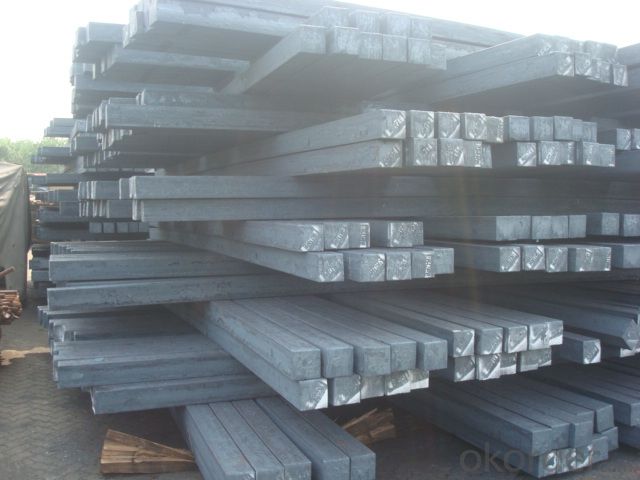
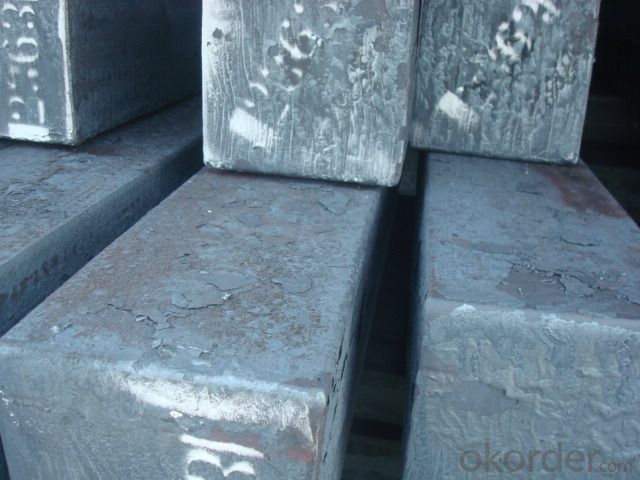
4. Steel Billet Produced by Big Blast Furnace Specification
Steel Billet Manufactured by Blast Furnace without Boron rolled steel, after processing can be used for mechanical parts, forging parts, processing all kinds of steel, steel Q345B channel steel, wire rod is the role of the billet. Steel billet is used in the production of semi-finished products, generally cannot be used directly for the society. Steel billets and steel are strictly divided into standard, cannot decide to whether the business enterprise of the final product, and according to unified standards to perform the whole society. Typically, billet and the steel is relatively easy to distinguish, but for some steel billet, and have the same specification and same steel purposes (such as rolling tube billet), whether can be used for other industries, whether through steel processing process, whether through a finished product rolling mill processing to distinguish
The classification of the Bloom Mainly from the shape is divided into two kinds: Slab: cross section width and height of the ratio of the larger, mainly used for rolling plate. Bloom: equal cross section width and height, or a huge difference, mainly used for rolling steel, wire rod.
Bloom material standard The thickness range: 150-240 - mm + / - 5 mm The width of the range: 880-1530 - mm + / - 20 mm Length range: 3700-10000 - mm + / - 500 - mm Cross-sectional size: 64 * 64 ; 82 * 82 ; 98 * 98 ; 124 * 124 ; 120 * 150 ; 152 * 164 ; 152 * 170 mm Length: 9000 mm The section of tolerance: Bloom: 1.0 + / - 2.0-1.0 + / - 1.0 mm The slab width: + / - 2.0 MM ; Thickness: + / - 3.0 MM
5.FAQ of Steel Billet Produced by Big Blast Furnace
We have organized several common questions for our clients,may help you sincerely:
①How is the standard you can meet?
For the chemical composition, according to the Chinese standard of GB700-88, and the section size according to the standard of YB2011-83,
②How is the chemical standard?
2
C%
Mn%
Si% S% P% Q215
A 0.09~0.15 0.25~0.55 ≤0.30 ≤0.050 ≤0.045 B 0.09~0.15 0.25~0.55 ≤0.30 ≤0.045 ≤0.045 Q235
A
0.14~0.22 0.30~0.65 ≤0.30 ≤0.050 ≤0.045 B 0.12~0.20 0.30~0.70 ≤0.30 ≤0.045 ≤0.045 C ≤0.18 0.35~0.80 ≤0.30 ≤0.040 ≤0.040 D
≤0.17
0.35~0.80
≤0.30
≤0.035
≤0.035
③How is the packaging and delivery?
Exporting Package with the steel material cover and the delivery term is based on the project.
- Q: Are steel billets used in the manufacturing of construction machinery?
- Yes, steel billets are commonly used in the manufacturing of construction machinery. Steel billets are raw material forms of steel that are heated and shaped into various components, such as plates, beams, and rods, which are essential in construction machinery production. These billets are known for their strength, durability, and ability to withstand heavy loads, making them ideal for constructing robust and reliable machinery used in the construction industry.
- Q: Are steel billets used in the manufacturing of oil and gas pipelines?
- Yes, steel billets are commonly used in the manufacturing of oil and gas pipelines. These billets are typically formed into seamless or welded pipes, which are then used to transport oil and gas over long distances. The high strength and durability of steel make it an ideal material for withstanding the harsh conditions encountered in the oil and gas industry.
- Q: How are steel billets used in the manufacturing of shipbuilding parts?
- The manufacturing of shipbuilding parts heavily relies on steel billets, which are vital in this process. These billets are essentially semi-finished steel products, usually in the form of rectangular or square bars, and are utilized as raw material for further processing in shipbuilding. To initiate the process, steel billets undergo rolling, where they pass through a series of rollers to decrease their cross-sectional area and increase their length. This rolling process converts the billets into elongated, slender sections of steel known as plates or sheets. These plates or sheets are then employed to fabricate diverse shipbuilding components, including hulls, decks, bulkheads, and superstructures. After the rolling process, the steel plates or sheets are cut into desired sizes and shapes using cutting machines or torches. These cut pieces are subsequently molded, bent, and welded together to form the necessary shipbuilding parts. For example, the steel plates can be bent and welded to create curved sections for the ship's hull, or they can be shaped into intricate forms for other components. Furthermore, steel billets are also utilized in the production of forged shipbuilding parts. In this scenario, the billets are heated to high temperatures and then subjected to intense pressure to reshape the steel. This forging process results in shipbuilding parts that are stronger and more durable, often used for critical components such as propeller shafts, crankshafts, and turbine blades. In conclusion, steel billets serve as the starting point in the manufacturing of shipbuilding parts. Through processes such as rolling, cutting, molding, and forging, these billets are transformed into plates, sheets, and forged components, all of which are crucial in constructing the various structural and functional elements of ships.
- Q: Can steel billets be used in the manufacturing of machinery?
- Yes, steel billets can be used in the manufacturing of machinery. Steel billets are semi-finished metal products that are typically hot rolled or forged into various shapes, including bars, rods, or sheets. These billets serve as the raw material for manufacturing machinery components such as gears, shafts, bearings, and structural frames. The use of steel billets in machinery manufacturing offers several advantages. Steel is known for its exceptional strength, durability, and resistance to wear, making it a suitable material choice for heavy-duty applications. Additionally, steel can be easily machined, welded, and formed into complex shapes, allowing for the production of intricate machinery parts. Moreover, steel's high melting point and thermal conductivity make it ideal for applications that involve high temperatures or require heat transfer. Overall, steel billets are widely used in machinery manufacturing due to their excellent mechanical properties, versatility, and reliability.
- Q: How are steel billets transported and stored?
- Steel billets are typically transported and stored in a careful and systematic manner to ensure their quality and safety. When it comes to transportation, steel billets are usually moved using trucks or railcars. Trucks are commonly used for short-distance transportation within a steel mill or between different facilities, while railcars are employed for longer distances, including intercity or even international transport. During transportation, steel billets are loaded onto the trucks or railcars using cranes or forklifts. It is crucial to secure the billets properly to prevent any movement or damage during transit. Straps, chains, or other securing methods are used to keep the billets in place and ensure their stability. Once the steel billets reach their destination, they are unloaded using similar lifting equipment. It is important to handle the billets with care during the unloading process to avoid any scratches or dents that could compromise their structural integrity. Regarding storage, steel billets are typically kept in designated areas called billet yards or billet storage facilities. These areas are designed to accommodate the size and weight of the billets and provide easy access for loading and unloading operations. Steel billets are often stored in stacks or piles, with each billet being carefully positioned to maintain stability and prevent any potential accidents. The billets may be organized based on various criteria, such as size, grade, or production date, to facilitate their retrieval when needed. To protect the billets from environmental factors, such as humidity or corrosion, they are often covered with protective coatings or stored in enclosed areas with controlled climate conditions. Additionally, regular inspections and maintenance are carried out to ensure the quality and integrity of the stored billets. Overall, proper transportation and storage procedures are essential to safeguard the steel billets and maintain their quality until they are ready for further processing or use in various industries.
- Q: What are the different types of steel billet rolling processes?
- There are several types of steel billet rolling processes, including hot rolling, cold rolling, and warm rolling. Hot rolling involves heating the billet to a high temperature and then passing it through a series of rollers to shape it into the desired form. Cold rolling, on the other hand, is performed at room temperature and involves passing the billet through rollers to achieve a desired thickness or shape. Warm rolling is a combination of hot and cold rolling, where the billet is heated to a lower temperature compared to hot rolling but higher than room temperature. Each of these processes has its own advantages and is used for different applications in the steel industry.
- Q: What are the different types of steel used in manufacturing steel billets?
- There are several types of steel used in manufacturing steel billets, including carbon steel, alloy steel, stainless steel, and tool steel. Carbon steel is the most widely used and contains a higher carbon content, providing strength and durability. Alloy steel incorporates additional elements such as manganese, nickel, and chromium to enhance its properties for specific applications. Stainless steel is known for its corrosion resistance and is commonly used in environments where rust is a concern. Tool steel is specifically designed for tools and machinery, offering high hardness, wear resistance, and toughness.
- Q: How are steel billets used in the manufacturing of marine components?
- Steel billets are used in the manufacturing of marine components as they serve as the starting material for forging, casting, or machining various parts like propellers, hull structures, valves, and shafts. These billets undergo further processing to form the desired shapes and sizes, ensuring the strength, durability, and corrosion resistance required for marine applications.
- Q: What are the main factors affecting the thermal expansion of steel billets?
- The main factors affecting the thermal expansion of steel billets include temperature, composition of the steel, and the grain structure of the material.
- Q: What are the different types of surface finish inspection methods for steel billets?
- Steel billets can undergo various surface finish inspection methods to determine their quality and suitability for further processing or use. Some commonly used methods for inspecting the surface finish of steel billets include the following: 1. Visual inspection: This method involves visually examining the surface of the billet for any irregularities, such as cracks, pits, scratches, or other imperfections. Although it is a quick and cost-effective method, it may not be able to detect subtle defects. 2. Magnetic particle inspection: This method entails magnetizing the billet's surface and applying fine iron particles to it. Any surface cracks or defects will cause a leakage of the magnetic field, attracting the iron particles and making them visible under appropriate lighting conditions. 3. Dye penetrant inspection: This method involves applying a liquid dye to the billet's surface. The dye seeps into any surface cracks or defects, and after a certain period, excess dye is removed. A developer is then applied, which draws out the dye from the cracks and defects, making them visible. 4. Ultrasonic testing: This method utilizes high-frequency sound waves transmitted through the steel billet. When the waves encounter any surface irregularities, such as cracks or voids, they are reflected back. By analyzing the time taken for the waves to return, the size and depth of the defects can be determined. 5. Eddy current testing: This non-destructive testing method utilizes electromagnetic induction to detect surface defects. An alternating current is passed through a coil, creating a magnetic field. When the coil is near the billet's surface, any defects disrupt the magnetic field, causing a change in the electrical impedance. This change is measured and analyzed to identify surface defects. Each of these inspection methods has its advantages and limitations. The choice of method depends on specific requirements, the size and shape of the billet, and the desired level of accuracy. Manufacturers can ensure the quality and reliability of the steel billets by employing these surface finish inspection methods before further processing or using them in various applications.
Send your message to us
Steel Billet Produced by Big Blast Furnace
- Loading Port:
- Tianjin
- Payment Terms:
- TT OR LC
- Min Order Qty:
- 1000 m.t.
- Supply Capability:
- 100000 m.t./month
OKorder Service Pledge
OKorder Financial Service
Similar products
Hot products
Hot Searches
Related keywords
